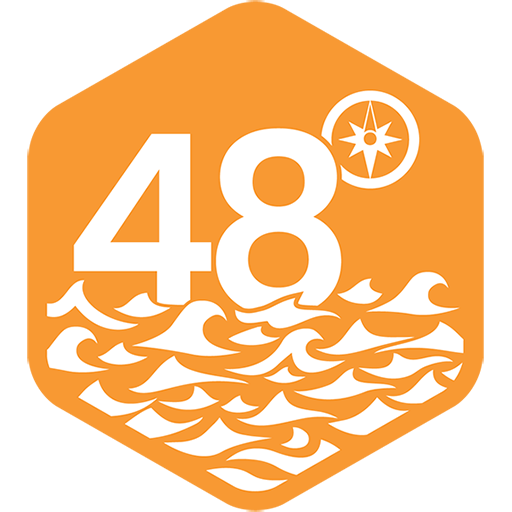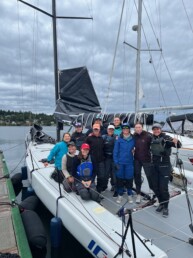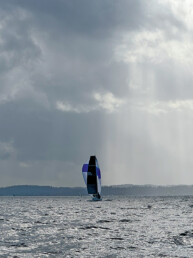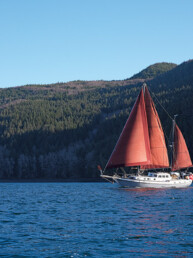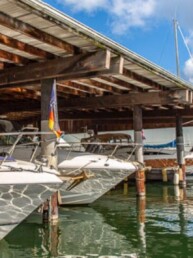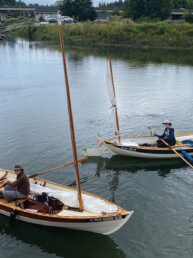Sampaguita, a 1985 Pacific Seacraft Flicka 20, auspiciously dropped anchor in La Paz, Mexico, on New Year’s Eve of 2023, after leaving Port Townsend, Washington, on August 22. She moved on to the Marquesas in the spring of 2024 and was back in Port Townsend by July. Part of the preparation for this voyage was a Vancouver Island circumnavigation shakedown cruise in June 2023. The shakedown was intended to test the boat’s refit and new equipment, try new techniques and build experiences, and see if I could, in general, “break some stuff.” I’ll review some of the value I gained from this cruise in preparing Sampaguita and myself to make the proverbial “left turn.” (That’s Pacific Northwest slang for going west out of the Strait of Juan de Fuca and heading south.)
Late summer is the season to leave when heading to points south from the Pacific Northwest, but I aimed to have Sampaguita’s refit finished by the end of May. A significant distance of 800 nautical miles when circumnavigating Vancouver Island in June (my second time around) would provide plenty of learning opportunities, wind (I’d hoped), fewer crowds, longer days, and ample time to make any necessary adjustments afterward. Having lived and sailed around the Pacific Northwest aboard Sampaguita for years, the domestic aspect was sorted, but there was still plenty of new gear and boundaries to be tested.
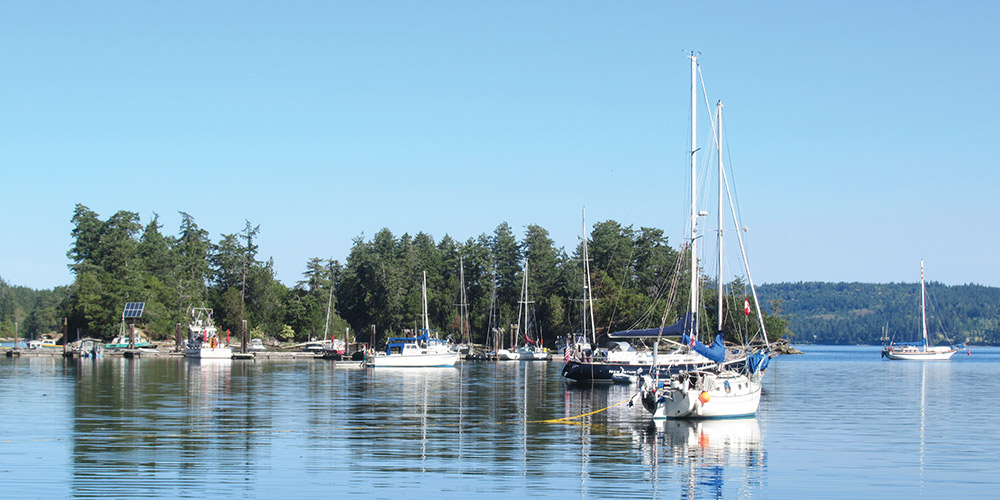
Navigation and Anchoring
On my previous trip in 2018, I had an armful of guidebooks and paper charts. In 2023, I used a combination of paper charts and Navionics on my phone, with the app providing crowd-sourced anchoring, tidal, and service information. OpenCPN and Coast Pilots were on a laptop computer but were never needed. Navionics was new to me for use on board. I have historically avoided phones and computers while sailing, and Sampaguita has never had a chartplotter.
The repeat rounding allowed the comfort of local knowledge and familiar paper charts to help accustom me to the Navionics display and master the features and functions of the program. When shooting the Yuculta Rapids/Gillard Passage/Dent Rapids hat trick in one slack, the timing was critical in a 20-foot boat. Having the Navionics integrated tidal data made it simple. Just beyond there, fighting the dual whammy of a contrary river and a building northwesterly, I scrolled for a close, protected place to anchor. My best bet was Thurston Bay Marine Park, though I had never been there. Reviews said the anchorage behind Block Island was not protected, and on my arrival, I concurred. It was full of chop. Deeper inside the inlet, Handfield Bay held more promise if I could get over the shallow entrance. Tidal and chart data implied I could make it with a few feet to spare on the rising tide. The reviews relayed positive experiences about the entrance and anchorage. I decided to go for it, and cleared with seven feet under the keel. I spent two nights alone in this secluded anchorage, waiting out the northwesterly gale, which I later learned was also bullying the Race to Alaska participants. Transiting the rapids and sussing the unplanned anchorage helped build confidence in the new-to-me equipment and how it would fit into my style.
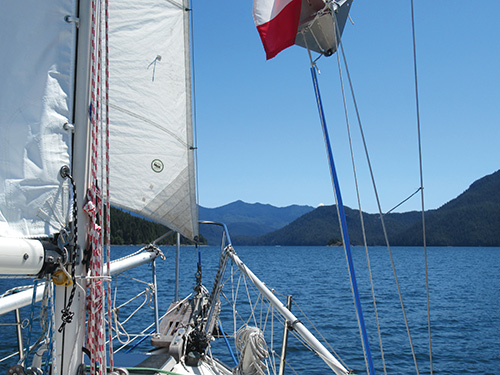
Offshore
I spent three days and two nights offshore on the west coast of Vancouver Island. Sailing 24/7 is something I had never done on Sampaguita or singlehanded. I left Bull Harbour just east of the Scott Islands at the northern tip of Vancouver Island, not touching down until Hot Springs Cove, halfway down. I rounded the notorious Brooks Peninsula 40 miles offshore with a northwesterly building to about 25 knots. I was queasy much of the time. It was excellent training, but not necessarily pleasant.
On both eves, I practiced going to sleep at night, either allowing the wind vane to do the steering or heaving-to. Sleep was elusive, but I went through the motions. I knew this was how it would be. There was a definite psychological hurdle to willingly allow the boat to seemingly catapult across the sea unattended at night. It offered a taste of what was to come: wetness, exhaustion, fear, and discomfort. It got easier as the months progressed but never entirely abated.
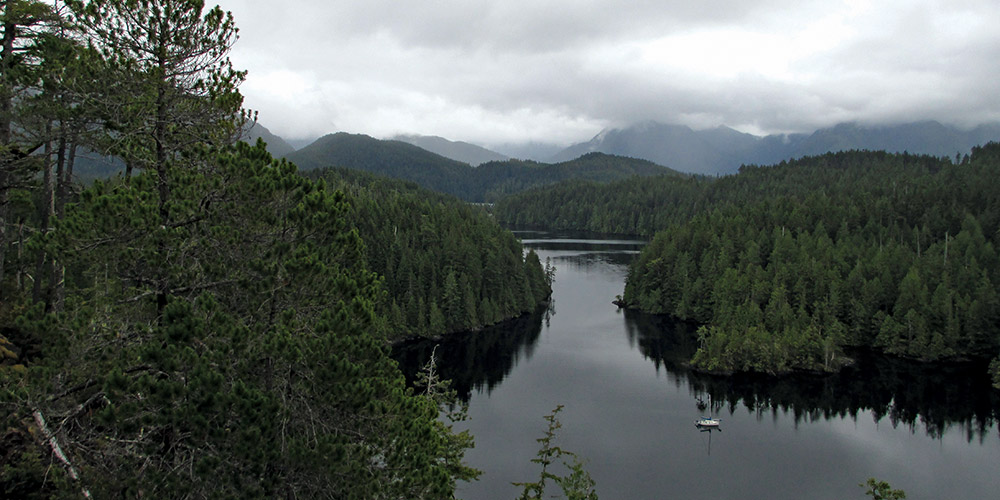
AIS
While offshore, I became accustomed to the new Standard Horizon GX2400 VHF with receive-only AIS and its CPA and TCPA alarms. As I mentioned, I was a bit seasick. These beeping alarms exacerbated my discomfort. I quickly realized the erratic movement of the antenna at the top of the mast in a sea state did not represent the true direction of Sampaguita’s travel and gave an inaccurate assessment of dangers. Alarms would start and stop continuously, and I was unable to safely and quickly stop them or turn the volume down regardless of how nauseous I was. I later reviewed the radio functions to affirm I understood them, which I mostly did. I knew what I would be in for as I “turned left” for the long jump down the West Coast to San Francisco through busy shipping lanes and fishing zones. Luckily, on the subsequent voyage, I never got seasick, so rather than nausea, I was just annoyed by the incessant beeping of the overzealous alarms.
Heaving-To
The practice of heaving-to went from theory to reality on this adventure. The wind continued to build with the second night offshore. Rather than bouncing across the sea at full speed and without a deck watch, seasick and uncomfortable, I decided to heave-to. I reefed the main down to the second, lashed over the tiller, put away the wind vane, and rode out the night. Sampaguita heaves-to with the main alone due to the full keel and a high bow, providing plenty of windage to prevent accidental tacking. Inside, I lay there, queasier than ever, just waiting for a knockdown.
The boat did fine. There would sometimes be a big bang and slight lurch as a wave broke against the hull, and I would think, “This is it.” But, no, the water would just run across the deck noisily. It all sounds so loud and intimidating inside the drum-like boat. It was just the beginning of learning and understanding Sampaguita’s limits—and importantly, my own—in heavier weather; and the adage that “the ship is often fitter than the sailor” rang true. Over the next year, my confidence increased. If this all sounds like a lot of hard work, it is. No worries, after the offshore segment, I landed at Hot Springs Cove and soaked alone in Ramsay Hot Springs under the moonlight to reward myself.
Sails and Rigging
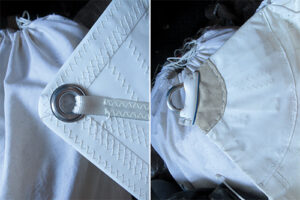
(Right) The sailmaker changed the clew to this end ring. The author added the piece of hose as a chafe guard from the pole. Also, notice the extra chafe protection on the sail.
I understood the importance of thoroughly working through anything I had changed with the boat. The same gear worked for years without a hitch. As soon as that gear was changed, I expected surprises. All boats are custom, with a good chance the exact part is no longer available, and its replacement presents a handful of subtle differences, no matter how similar they seem.
Case in point: I bought new sails. The 100% jib had a different stainless-steel clew ring than the previous one. The old jib clew ring was metal but rounded with nylon to soften the edges. It gave me no issues for ten years, and since I had never bought new sails before, this subtlety went over my head at first. This new clew ring was a quality and oft-seen piece of gear but had a hard edge that started catching on the strands of the starboard main shroud when tacked. An annoyance, initially not much considered, it quickly got scary. I was short-tacking up Trincomali Channel in the Gulf Islands on the eastside of Vancouver Island in 13 knots of wind, having a grand sail, when the clew ring started significantly hanging up. In addition, the leech line cleat had begun catching on the same shroud. Eventually, the jib positively fouled, backwinded, loaded up, and pulled the shroud several inches out of alignment until the sail finally let go. The shroud complained with an unnerving “SSPPRRRUUNNGGG!” It was scary enough that I used the old jib for the rest of the shakedown.
On my return, the sailmaker graciously changed this clew ring out for an end ring, changed out the leech line cleat for one with a smoother profile, and added some chafe protection, which all worked great. I even changed out the marred shroud as an added precaution. I wanted to start the Pacific voyage without blemishes in the rig. Since I was on home turf and used local vendors for my sails and rigging, fixing these issues was quick, easy, and economical upon return. The sailmaker fixed the clew as part of his guarantee, and a new shroud came from my favorite rigger.
This particular situation alone made the shakedown worth it. Much of the cruise was learning and familiarity. This, however, fell into the “break some stuff” box. Without a shakedown, these issues and subsequent repairs would have occurred in San Francisco, Mexico, or the Marquesas. As I later observed with fellow cruisers, those options would have been more costly, slower, and less friendly.
Self-Steering Wind Vane
The freshly installed self-steering wind vane proved itself a most valuable player and gave me confidence it was up to the task required in its future of 24/7 voyaging and trade winds. It worked like a charm for the three-day and two-night offshore stint. The vane loved to steer the boat in following winds and was simple to deploy and adjust, provided I had the proper amounts of sail up. The vane was a last-minute, bite-the-bullet addition, and I couldn’t have done the voyage without it. I mentioned I was queasy much of the shakedown’s offshore segment, but the vane was unphased.
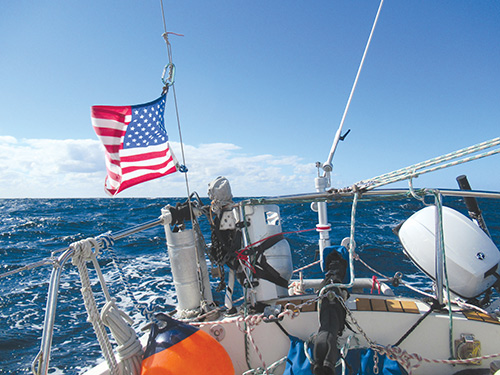
The Outboard
I learned the limitations of the new and less powerful Tohatsu 6hp outboard engine. I previously used an 8hp Yamaha high-thrust motor, but it had developed corrosion in the tilt and lifting mechanism. It was an excellent engine and pushed Sampaguita at hull speed, but at 105 pounds, it was a lot of weight hanging from the transom of a 20-foot boat, visible by the slight deformation it had undergone in the 15 years it was on.
The new Tohatsu weighed 61 pounds. When I realized I had to install a self-steering wind vane, I decided to lose weight in the engine to gain weight with the vane. I had chosen a Windpilot Pacific Light because it was the right size for small boats. I had to have a bracket manufactured to accommodate the transom-hung rudder, with the whole installation weighing around 50 pounds.
The new engine had less power and top speed. I learned its operational sweet spot for Sampaguita was about 3.5 knots. This medium throttle would keep the engine from bogging down while pushing a 7,000-pound, fully loaded, full-keeled boat. More throttle was diminishing return, achieving at most 5 knots under easy conditions. But then, it was much louder, with twice as much fuel consumption, and created significant variability in operational hours with a 31-liter fuel capacity to consider.
Crab (or is it Lobster?) Pots
A crab pot, which would be a lobster pot in Mexico, became a continual reminder as I traveled south. I was arriving in Port Renfrew, near the entrance of the Strait of Juan de Fuca, when a squall set in. Approaching the marina, the first of the shakedown, I carelessly got the rudder hung up on a crab pot line. Snagging a pot has happened before under relatively benign conditions but never under heavy wind. The pot anchored the boat by the rudder, and the pressure of the float had the line very taut. There was too much pressure to pull the line up and cut it. Finally, I hooked onto the line to push it down and off, reaching through the wind vane bracket for the best angle. Sure enough, the line came off, the boat quickly blew forward, and the pot line sprung back, taking the boat hook with it, bending and breaking it against the bracket. Shoot. I knew that was going to happen.
The value of the crab pot lesson came into its own when reaching the west coast of Baja, Mexico, where the main local commercial fishing endeavor is lobsters. Nearly every bay entrance is a minefield of pots. There is likely a 30-foot lead of floating polypropylene line (not leaded) upwind or up-current of the buoys. I remembered the crab pot lesson whenever entering a bay under power, at night, or with a strong breeze.
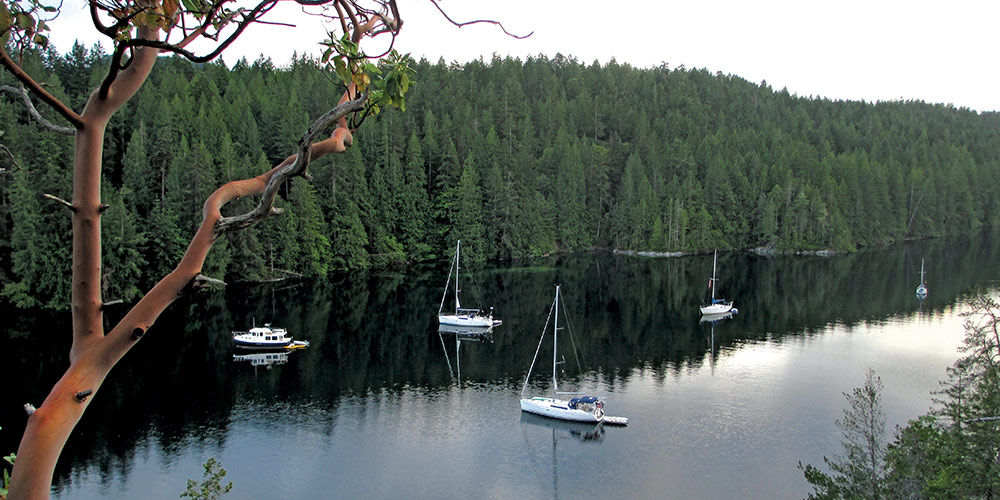
Wrap-up
Sampaguita’s Vancouver Island shakedown session was an expedition unto itself. New equipment, experiences, and techniques made for exciting learning. It gave me that final bit of confidence that she and I were ready to take on bigger things, the work put in, and the gear sorted out.
Though this article primarily presents a technical perspective about preparing and practicing for even bigger voyages, the shakedown was not without romance. A day’s joy of Pacific Northwest cruising comes to a head at a peaceful anchorage. New-to-me spots—remote-feeling Clark Island Marine State Park in the San Juans; the secluded southern arm of Secret Cove on the Sunshine Coast where I dropped the hook after crossing the Strait of Georgia; or Charles Bay, tucked in, north of Eclipse Islet, unbothered by the swift current of nearby Blind Channel—offered fresh flavors in familiar surroundings. Anchoring in Alert Bay and exploring Cormorant Island’s Big Tree Loop trail were firsts and worthwhile alternatives to nearby Port McNeill. Lest we forget two nights in Hot Springs Cove in Clayoquot Sound, pampering myself after my first “landfall.” Cruising in this region really provides too many highlights to name.
And there is the joy of the process. Upon returning, the sail clew was adjusted, the damaged shroud changed, I bought a new boat hook, serviced the outboard, hauled the boat for inspection and bottom paint, and counted my days to the proverbial “left turn.”
Joshua Wheeler has lived and sailed on small craft for over 15 years and 25,000 nautical miles. Credits include a 2019 transit of the Northwest Passage aboard Breskell, two solo circumnavigations of Vancouver Island in 2018 and 2023, the Inside Passage to Alaska in 2022, and a Pacific tour in 2023-24. He holds a USCG 100-Ton Inland Master’s license and 25-Ton Near Coastal, has a recurring column in ‘Lectronic Latitude and Small Craft Advisor’ called The Resourceful Sailor Series, and enjoys local small boat racing with the Port Townsend Sailing Association.
Josh Wheeler
Josh Wheeler is an avid writer and sailor who lives aboard on his 20-foot Flicka sailboat. Follow his adventures at sailingwithjosh.com
